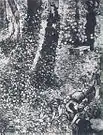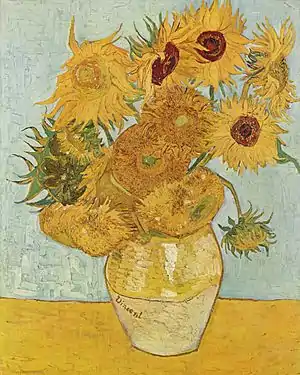Vincent van Gogh's display at Les XX, 1890
Vincent van Gogh's display at Les XX, 1890, in Brussels is an important testament to the recognition he received amongst avant-garde peers during his own lifetime. Participation in the annual exhibition of Les XX was for members and by invitation only. Van Gogh's choice proves that he was going for more than a simple selection of paintings he considered superior, but that he was willing to provide a well reasoned summary of his years of work in Provence. Evidently this notion remained neglected, and even more: it was washed away by the scandal his works provoked. Then the same works were again shown at the annual exhibition of the Artistes Indépendants in Paris which offered space for an expansion of the display: this was done by Theo van Gogh, the brother of Vincent, who was suffering from long lasting mental problems.
Paintings included
In November 1889, Van Gogh selected six of his paintings, all size 30 canvases, to be displayed at Les XX, in 1890. On the back of the letter of invitation from Octave Maus, dated November 15, 1889, there is a pencil sketch[1] that gives some hints for the display Van Gogh proposed, and for its artistic background. His reply to Maus, dated (?) November 20, 1889,[2] supplied the titles later printed in the catalogue, but did not point out the arrangement he intended:
- 1. Tournesols - Sunflowers
- 2. Tournesols - Sunflowers
- 3. Le lierre - Ivy
- 4. Verger en fleurs (Arles) - Flowering Orchard (Arles)
- 5. Champ de blé; soleil levant (Saint-Remy) - Wheat Field, Sunrise (Saint-Rémy)
- 6. La Vigne rouge (Mont-Major) (!) - Red Vineyard (Mont-Majour)
The missing information can easily be compiled from other parts of Van Gogh's correspondence; there is now agreement that Van Gogh's exhibit can be reconstructed in the order of paintings below:
 |
 |
 |
 |
 |
 | ||||
(Arles, November 1888). Pushkin Museum of Fine Arts | ||||
Ivy, the center piece of Van Gogh's arrangement, has been lost without trace since World War II; Hermann Göring is the last person photographed (by Hans Hoffmann) with this canvas while it was stored, together with other works of art confiscated from French Jewish collections, in the Jeu de Paume Galleries. Van Gogh indicated his two Sunflowers (size 30 canvases) were to be displayed either side of Ivy. To the left and right of this upright triptych, he wanted to place the Flowering Orchard and the Wheat Field at Sunrise. Finally, he indicated Red Vineyard was to be hung (at the top or) underneath this arrangement.
"Impressions of Provence"
The four landscapes depict traditional notions of the four seasons: flowering trees in spring, a shaded hiding place in the midst of ivy in summer, the vineyard harvest in autumn, and new wheat on the furrows in winter. In between the seasons were embedded the heraldic flowers of Provence — sunflowers, dear to the artistic and literary circles of the Félibres, the néo-provencal movement around Frédéric Mistral.
These seasonal links are set not only in subject matter, but — and from Van Gogh's point of view even more important — reinforced by the choice of colour. Each of the six paintings is dominated by one of the six primary colours (yellow, red, blue, and their complementaries orange, green, and violet). He uses yellow and orange in the two Sunflowers-versions, red in the vineyard, green in the ivy, blue in the orchard, and violet in the field. Thus, the full colour spectrum is manifested in this selection, which can consequently be read as a single entity, "a whole" (French: un tout).
Earlier this year, Van Gogh had already expressed his wish before returning to the North to summarise his "impressions of Provence".
Scandal and success

The exhibition of Les XX opened January 18, running till February 23. Two days before the opening, Henry de Groux announced that his works would not be seen side by side with the "abominable Pot of Sunflowers by Monsieur Vincent or any other agent provocateur".[3] At the opening dinner, De Groux once again attacked Van Gogh's paintings and called him
- an ignoramus and a charlatan. At the other end of the table Lautrec suddenly bounced up, with his arms in the air, and shouted that it was an outrage to criticize so great an artist. De Groux retorted. Tumult. Seconds were appointed. Signac announced coldly that if Lautrec were killed he would assume the quarrel himself.[4]
That same evening, Les XX expelled De Groux from their association; the next day he apologised and was allowed to resign. Thus the duel was averted, and Paul Signac was soon one of two supplementary members elected to Les XX.
One work of Van Gogh's exhibit was sold, The Red Vineyard.[5] The buyer was Anna Boch,[6] a painter and member of Les XX since its foundation and sister of Eugène Boch, who was also a painter and a friend [7] of Vincent van Gogh.
Altered exhibit at the Artistes Indépendants
The Artistes Indépendants, collaborating closely with Les XX in Brussels, were eager to present Van Gogh to the public in Paris in an even broader scale, and finally showed ten paintings in their 6th annual exhibition, March 20 through April 27, 1890:
- 832. Le cyprès. - The Cypres
- 833. Paysage montagneux en Provence. - Mountain landscape in Provence
- 834. Rue à Saint-Rémy. - Street in Saint-Rémy
- 835. Les Alpines. (!) - The Alpilles
- 836. Promenade à Arles. - Promenade in Arles
- 837. Mûrier en automne. - Mulberry tree in autumn
- 838. Sous-bois. - Underwoods
- 839. Lever de soleil en Provence. - Sunrise in Provence
- 840. Les Tournesols. - The Sunflowers
- 841. Verger d'oliviers en Provence. - Olive orchard in Provence
Evidently, the first part of Van Gogh's exhibit (832. - 837.) was now chosen by Theo, while the remainders from Brussels were added (838. - 841.) at the end of this selection, excluding one version of the Sunflowers (and The Red Vineyard sold in Brussels).
Again, Van Gogh exhibit was the clou of the show: Gauguin, Guillaumin and other colleagues proposed to exchange works;[8] Duez sent his compliments; and Theo wrote to Vincent on April 23 that Monet had said, "your pictures were the best of all in the exhibition".[9]
- Some of Van Gogh's paintings in the Artistes Indépendants show
 838. Underwoods. Present whereabouts unknown.
838. Underwoods. Present whereabouts unknown. 839. Lever de soleil en Provence. Present whereabouts unknown.
839. Lever de soleil en Provence. Present whereabouts unknown. 840. Sunflowers (Arles, August 1888). National Gallery, London, United Kingdom.
840. Sunflowers (Arles, August 1888). National Gallery, London, United Kingdom. 840. Sunflowers (Arles, August 1888). Neue Pinakothek, Munich, Germany.
840. Sunflowers (Arles, August 1888). Neue Pinakothek, Munich, Germany. 841. Verger d'oliviers en Provence. Neue Pinakothek, Munich, Germany.
841. Verger d'oliviers en Provence. Neue Pinakothek, Munich, Germany.
Resources
Notes
- Roland Dorn 1988, ill. 7
- Letter 614b to Maus; see also Letter 614 to Theo.
- Madeleine Octave-Maus, p. 100; quoted by John Rewald, p. 346
- Octave Maus, quoted by John Rewald, p. 346-347
- More about the Red Vineyard Painting
- Anna Boch.com Website about the Woman that bought The Red Vineyard
- Eugene Boch friend (or even boyfriend ?) of Vincent van Gogh
- Letters GAC 40 from Gauguin to Van Gogh, April 1890 (?) (Paul Gauguin: 45 Letters, ed. Douglas Cooper, The Hague 1983, p. 304-311 ISBN 90-12-03899-5), Letter T29 from Theo to Vincent, 19 March 1890, and Letter 630 from Vincent to Theo, 1 May 1890
- Letter T32 from Theo to Vincent, 23 April 1890
References
- Dorn, Roland: Vincent van Gogh's Concept of "Décoration", Vincent van Gogh International Symposium, Tokyo, October 17, 18, 19, 1985, Tokyo 1988, pp. 375–403 (in English and Japanese)
- Octave Maus, Madeleine: Trente années de l'lutte pour l'art, Librairie L'Oiseau bleau, Bruxelles 1926; reprinted by Éditions Lebeer Hossmann, Bruxelles 1980
- Rewald, John: Post-Impressionism: From van Gogh to Gauguin, revised edition, Secker & Warburg, London 1978, pp. 346–347